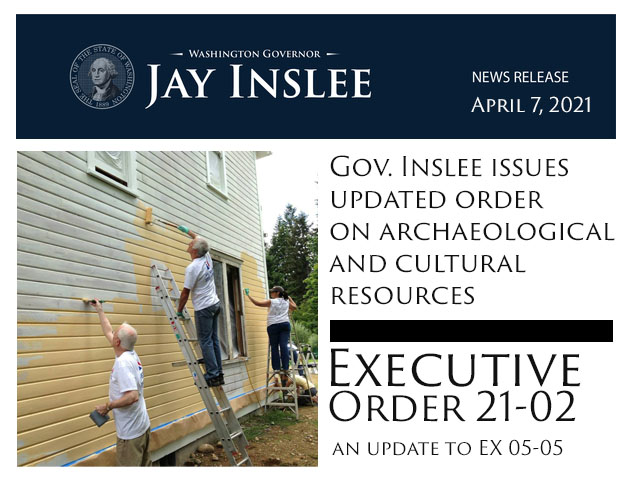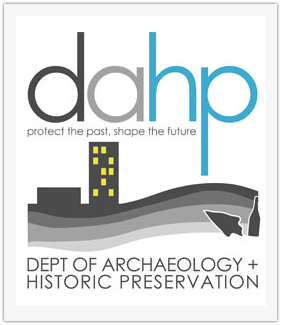Governor's Executive Order 21-02 (formerly 05-05)
What is it?
Governor Jay Inslee signed Executive Order 21-02 on April 7, 2021. It replaced former Executive Order 05-05, signed by Gov. Chris Gregoire in 2005. GEO 21-02 requires state agencies using capitol funds to consider how proposed projects may impact cultural resources.
The process includes obtaining letters from both DAHP and the tribes for pre-design and design phases to avoid adverse impacts to archaeology and historic resources.

Capitol projects that fall under 21-02 include:
- new construction
- demolition
- ground disturbance
- rehabilitation/renovation
- acquisition
So You Need a 21-02 Letter from DAHP?
If you are told you need a letter from DAHP under GEO 21-02, please follow the below steps:
To initiate consultation:
-
State agencies are tasked with initiating consultation with DAHP and affected tribes early in the project planning process and must complete consultation before the funded project can proceed.
-
Consultation can be delegated to recipients of state funds, however it is still the state agency’s responsibility to ensure an adequate consultation process and will be responsible for holding all records related to the tribal consultation process. Agencies must provide proof of tribal consultation to DAHP as well.
-
The state agency (or delegated recipient) should submit an EZ/Project Review Form. This form should be filled out, with no blanks, or it will be sent back for changes. Submit the Project Review Form and all subsequent correspondence to 2102@dahp.wa.gov. For more information about the form, please check out our EZ/Project Review Form page.
-
If you do not hear back within 30 days, please feel free to reach out and inquire about the status of your review.
DAHP Response to Your Request:
The following are the possible responses from DAHP and what they mean:
-
“More Info Needed/Survey Requested”: DAHP does not have enough information to make a determination of effect.
= Respond to DAHP with the requested information. They will then follow-up with another response
-
“No Cultural Resources Impacted”: No eligible cultural resources are present in the project area.
= Consultation w/DAHP is complete!*
-
“No Adverse Impact”: Eligible cultural resources were identified, but the project will not impact the resources’ eligibility to the National Register of Historic Places.
= Consultation w/DAHP is complete!*
-
“Adverse Impact”: Eligible cultural resources were identified, and the project will cause significant impacts to the resources’ eligibility to the National Register of Historic Places.
= You must now work with DAHP to resolve the adverse impacts.
* - “No further consultation required” UNLESS…
- there is a change in scope for the project;
- or there is an inadvertent discovery.
Then, you must reinitiate consultation with DAHP/ the Tribes.
Resolution of Adverse Impacts
Under EO 21-02, DAHP encourages the agencies and project proponents to avoid or minimize adverse impacts. If you cannot avoid or minimize adverse impacts, the agency will develop a mitigation plan:
-
Archaeology Mitigation
- Mitigation for impacts to archaeological sites and resources is decided and documented through the issuance of archaeological monitoring and excavation permits as described in WAC 25-48.
- Projects that impact archaeological sites or resources must obtain an archaeological monitoring or excavation permit from DAHP as required by RCW 27.53.
-
All Other Mitigation (Buildings, Structures, Sites, Objects, Traditional Cultural Places, and Sacred Sites)
- You will develop a "Memorandum of Understanding" (MOU) or stipulate the mitigation plan in the agency grant agreement/contract. For more information please see our mitigation page.




